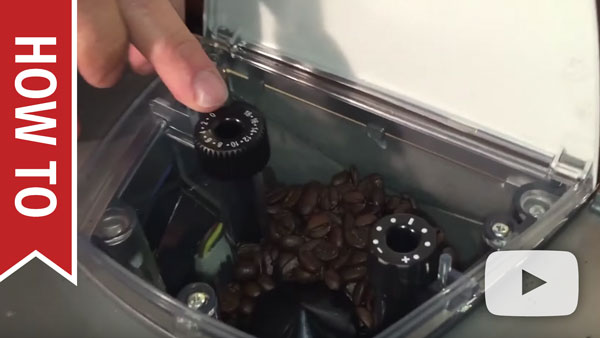Troubleshooting-Gaggia-Titanium-Grinder-Cleaning
From Whole Latte Love Support Library
The grinder may be blocked. This typically happens if beans are being used that are not compatible with the machine. This machine does not accept oily, caramelized, or flavored beans. Use of these beans can cause permanent damage to the machine that is not covered under warranty. These beans can be identified easily. They will be shiny and feel slippery or sticky. Dry beans that are appropriate for the machine will look dull and feel rough.
- Do the cleaning and calibration instructions in this video.
- After reassembling the machine according to these instructions do not add beans in. First make sure the grinder adjustment knob is set to the coarsest setting, which is the 18 setting. Make sure not to do this until the grinder assembly is fully assembly. If you set the grind coarseness to 18 while reinstalling the hopper it will throw the grinder out of calibration and the cleaning and calibration instructions will need to be done again.
- Add beans back into the machine. The beans must be dry, do not add oily beans back into the unit.
- If this clears the no beans error and shots are pulling successfully on this grind setting then you can move the grind back to the original setting. Only move the knob a few numbers at a time, and only while the grinder is running. To do this press one of the drink options to start a shot, and then when the grinder turns on make the adjustment.
- If this does not clear the no beans error, there is no sensor on the grinder to communicate to the control board that the machine is out of beans like on other Gaggia machines, so the issue is likely that the microswitch at the trap door is not being activate. There are a few reasons the microswitch may not be activating:
- The beans being used in the machine are not the correct type. If the beans are a dark roast that are shiny in appearance, the oils from the beans could be preventing the microswitch and trap door from operating properly
- The burrs in the grinder could be worn out or broken
- The trap door may be stuck
- The microswitch may have failed
- The control board may not be functioning properly
- To test to see whether or not the microswitch is being activated, select one of the three buttons to brew a coffee. As soon as the machine begins grinding, turn the dose knob, which goes from plus to minus to a lower (minus) setting. This will draw the trap door into the grinds that are stuck in the chute, which should activate the microswitch. If it does, then the issue is a stuck door or malfunctioning microswitch.
- If the machine successfully completes the brewing cycle, try performing another brewing cycle with the dosing knob still on the lower setting. If the machine successfully brews again, try increasing the dose amount. If the machine brews successfully again, the trap door was likely just stuck, and the issue is likely resolved.
- If the issue comes back, first try manually and thoroughly cleaning the trap door area. If this does not resolve the issue, the burrs should be replaced.
